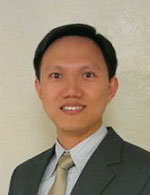Yang Awarded Welch Professorship by TcSUH
Research Involves Ultrafast Electron Imaging Techniques
 Ding-Shyue (Jerry) Yang, an assistant professor in the Department of Chemistry, has
been awarded a Robert A. Welch Professorship in High Temperature Superconducting and
Chemical Materials from the Texas Center for Superconductivity at University of Houston
(TcSUH). The appointment, typically for two years, was effective Sept. 1.
Ding-Shyue (Jerry) Yang, an assistant professor in the Department of Chemistry, has
been awarded a Robert A. Welch Professorship in High Temperature Superconducting and
Chemical Materials from the Texas Center for Superconductivity at University of Houston
(TcSUH). The appointment, typically for two years, was effective Sept. 1.
The Robert A. Welch Foundation created the endowed professorships at TcSUH to assist with recruitment and retention of outstanding faculty, research faculty and visiting scientists.
“The Welch Foundation funding will support my research program and allow me to make contributions toward a better understanding of high-temperature superconductors and energy-related materials,” said Yang, who joined the UH chemistry department a year ago. “I’m grateful and honored to receive this endowed professorship.”
Yang’s research focuses on two novel electron-imaging techniques, called ultrafast electron diffraction and time-resolved scanning electron microscopy, to study materials and interfacial phenomena.
“With the funds from the foundation, I will be able to examine the unconventional properties and dynamic behaviors of strongly correlated transition-metal oxides,” Yang said. “These types of materials are particularly attractive for their potential applications in electronic and optoelectronic devices that conventional metals, semiconductors, and insulating materials are unable to achieve.”
For about three decades, scientists have been able to use laser-based, time-resolved spectroscopic methods to examine the nonequilibrium dynamic behaviors of matter that occur on ultrashort time scales, spanning typically from the ultrafast femtosecond (10–15 second, or one millionth of one billionth of a second) to the nanosecond (10–9 second, or one billionth of a second) range. Yang’s techniques of ultrafast electron imaging, developed only recently within the last decade, are novel and unique in that they not only have the ultrafast temporal resolution required for time-resolved studies but also inherit the high spatial resolution from the electron imaging methods for direct detection of atomic motions.
Yang has the ability to directly look at the small atomic changes in materials induced by a femtosecond laser pulse and thereby discover the road map for the transformation of laser-excited matter from one phase to another. Such information of ultrafast dynamic behaviors may shed light on the unconventional properties of correlated materials that have been puzzling to scientists for years.
"TcSUH’s growing energy materials programs will benefit greatly from the work of Professor Yang,” said Allan Jacobson, director of TcSUH and Robert A. Welch Chair of Science in UH’s chemistry department.
Before joining UH, Yang performed his doctoral and postdoctoral research at the California Institute of Technology under the supervision of Nobel laureate Dr. Ahmed Zewail. Along with his colleagues, he developed ultrafast electron diffraction for materials and surface studies from its inception. As a postdoctoral scholar and research scientist, he designed and built an ultrafast scanning electron microscope, the first such scanning microscope in the world that allows the imaging of materials dynamics on the ultrashort time scale.
At UH, Yang is building his experimental instrument by combining the two ultrafast electron imaging techniques and conventional time-resolved spectroscopy into a single apparatus for materials and interfacial studies. More information about his research program can be found on his homepage.